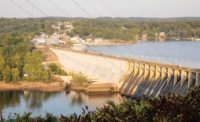2023 MidAtlantic Best Projects
Best Project Specialty Construction: Martin Marietta Texas Quarry Highwall Stabilization

Photo courtesy GeoStabilization International
Martin Marietta Texas Quarry Highwall Stabilization
Baltimore
BEST PROJECT
Submitted By: Geostabilization International
Owner: Martin Marietta Materials
Lead Design Firm | General Contractor: GeoStabilization International
Structural Tie-in Plan Support: CW Services
This innovative project required stabilizing two areas of a quarry that were experiencing frequent rockfalls and that posed a risk to critical infrastructure under construction. The $446,000 design-build stabilization project involved an outer highwall corner stabilization for a primary crusher station, rockfall along the conveyor near the highwall and the installation of six micropile caps to structurally support the dump ramp deck. It was completed at budget on schedule in two months despite many obstacles.
In the highwall corner near the primary crusher station, the team’s analysis revealed a recent year-long outer bench failure that caused significant slab failure and smaller block failures. A combination of the rock mass jointing and the ripple effect from heavy joint structure heaving created poor conditions. They required the team to remove existing mesh before using rock bolts and a reinforced layer of shotcrete to reinforce the area. After removing existing mesh, they completed necessary drilling, scaling and shotcrete application before replacing and rehanging the drape mesh.

Photo courtesy GeoStabilization International
In the second area, where rockfalls had occurred over the last year on a 900-ft slope near the future conveyor, the crews used a variety of scaling techniques to remove loose debris and install rock anchors for additional support. That task was particularly challenging because work in the upper crest area was constrained, but the team was able to coordinate successfully to keep crews safe.
Installing micropiles to support the dump rack required teamwork. The team joined with CW Services to devise a structural tie-in plan that involved drilling into more stable rock away from the face. Crews worked with ropes for up to six days to install the micropiles, prepare and form the cap and place the concrete. Team members who partnered in this phase of the work included CW Services for rebar cage completion, Martin Marietta Materials’ Texas, Md. site for crane support and GeoStabilization crews for concrete/shotcrete placement.

Photo courtesy GeoStabilization International
To carry out this complex project and fully understand site conditions, the team’s analysis employed advanced technologies including structural mapping and historic ground change detection.
Aside from successful teamwork for the project, the use of innovative techniques, advanced design elements and effective application of new technology are expected to have lasting value for the owner, the community and the construction industry, according to the team. In addition, by incorporating advanced design elements to enhance the durability of structures, the approach should achieve cost savings for the client and superior infrastructure quality for the community. Lessons learned from this project can also be shared industry-wide to promote best practices and advance standards for solving geological challenges.

Photo courtesy GeoStabilization International



